Poha idli recipe with step by step pics. These are amazingly soft, light and fluffy idli varieties made with poha (parched rice), idli rice and whole urad dal (husked whole black gram). It makes for a healthy and delicious breakfast or lunch when paired with coconut chutney and sambar.
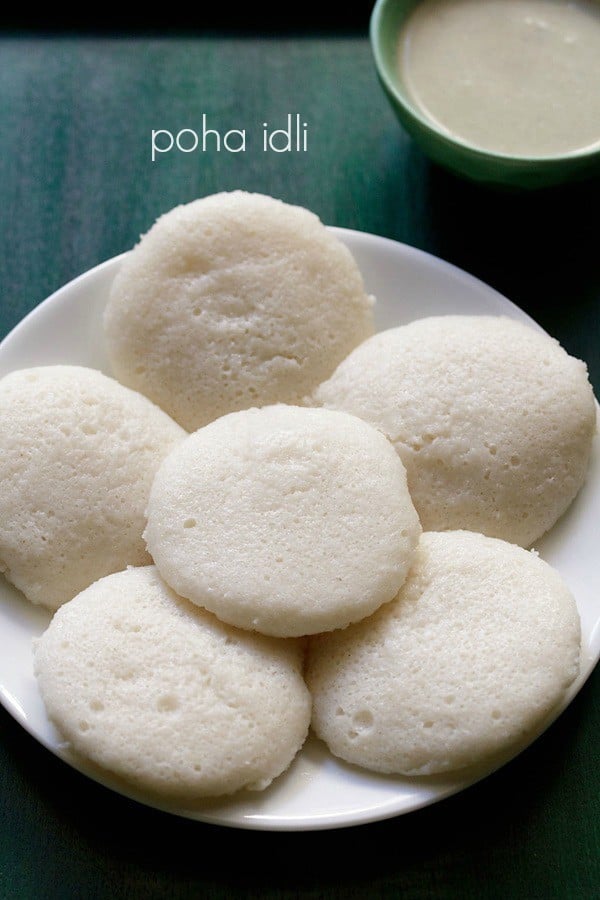
Poha is flattened rice. You can use thick or thin poha. If you do not have idli rice, then use parboiled rice or sela chawal. You can also use any regular rice like sona masuri or parimal rice. Also make sure that the urad dal is fresh and not close to its expiry date.
These poha idli has 1:1 ratio of poha and idli rice in cup measurement. The amount of urad dal added in this recipe is also less.
While making any idli batter, do remember that temperature is very crucial for proper fermentation of the batter. In cold climates, fermentation does not happen well. I get a lot of queries on the fermentation of idli batter in winters. So summarized my experiences in this Dosa Recipe.
The day I made these poha idli, the temperature in the night dropped to 16 degrees celsius and I kept the batter for around 15 hours in a warm place in my kitchen.
The South Indian snack of idlis is not only healthy but also a good breakfast to start your day. You can also pack them in the tiffin box and they stay soft even later. Idli, dosa, uttapam are one of those perfect food for me, which I can have every day and even for lunch and dinner.
These poha idli are so soft that you would love to dunk them in sambar and coconut chutney. In fact even a vegetable korma will go very well with them. I make Set dosa using a similar proportion.
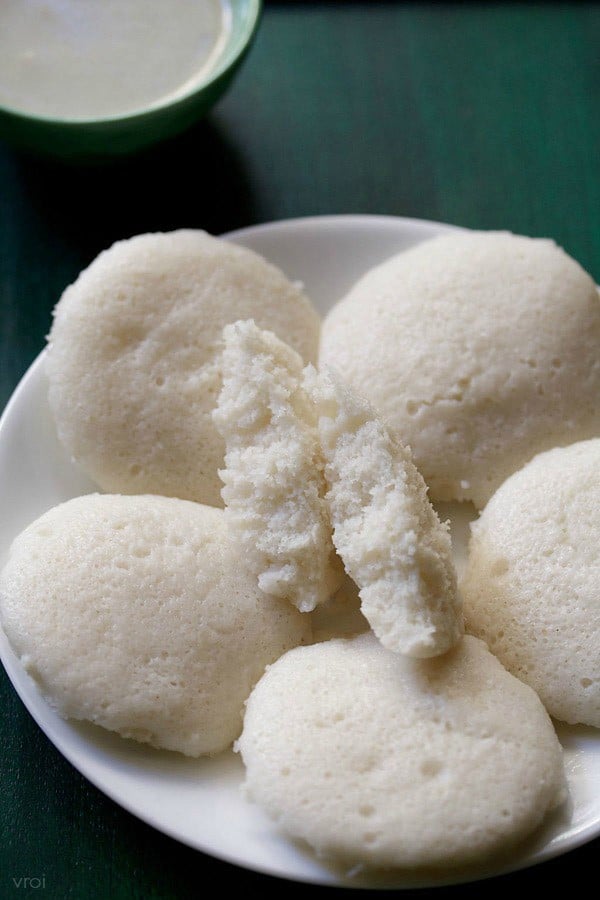
How to make Poha Idli
1. In a bowl or pan, take the following ingredients – 1 cup idli dosa rice or parboiled rice (200 grams), 3 tablespoons of whole urad dal (40 grams of husked whole black gram) and ¼ teaspoon fenugreek seeds (methi seeds). I used idli rice.
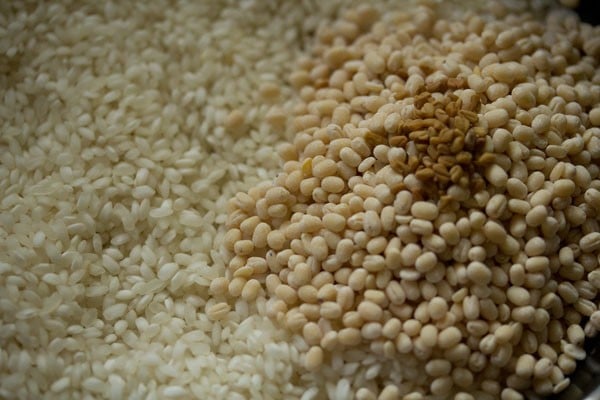
2. Rinse them for a couple of times in fresh water and then soak them in a bowl with 2.5 cups of water.
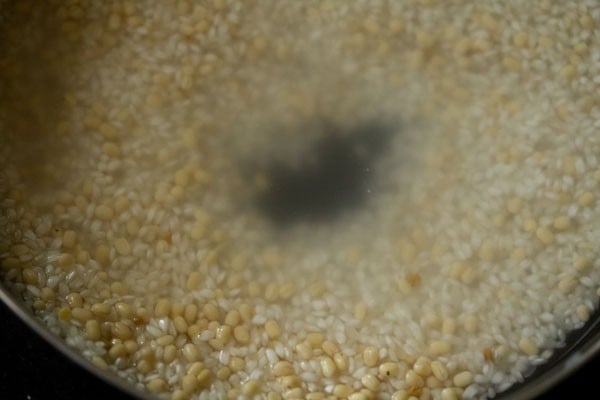
3. Next, in a separate bowl or pan, take 1 cup thick poha (80 grams).
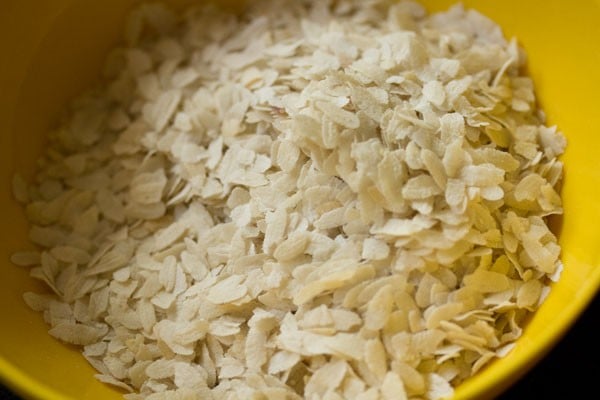
4. Rinse the poha once or twice with water.
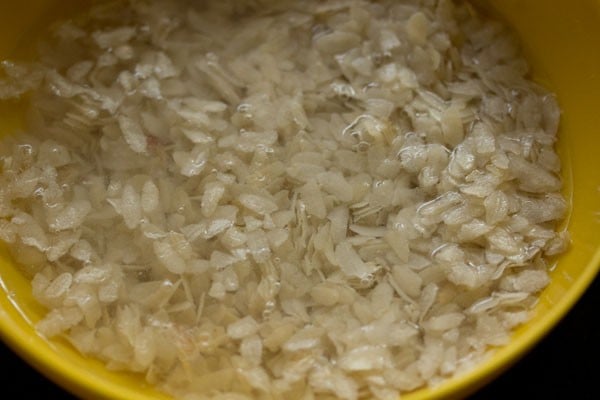
5. Strain the water and add the poha to the bowl containing rice, urad dal, methi seeds and water.
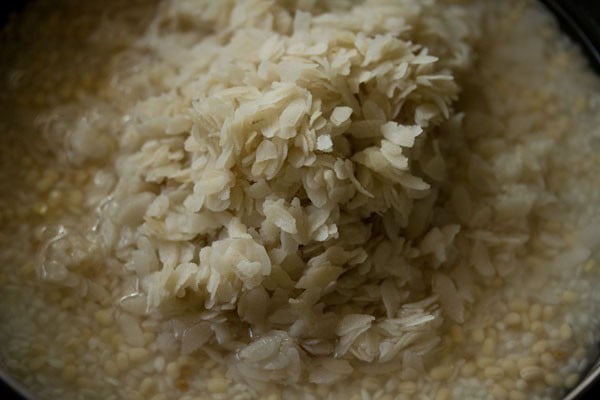
6. Mix well. Cover the pan and soak these four ingredients in water for 5 to 6 hours.
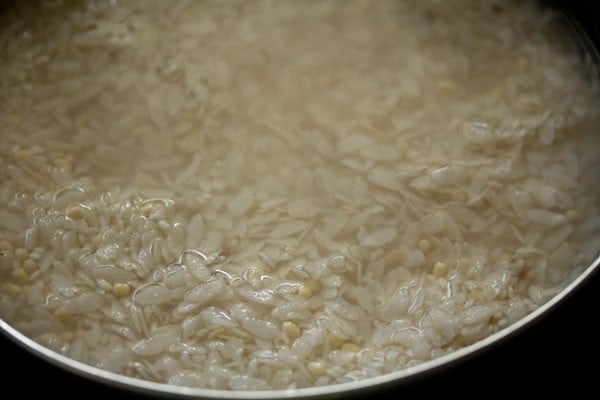
7. Later, strain very well. Reserve the strained water. We will use this strained water for grinding.
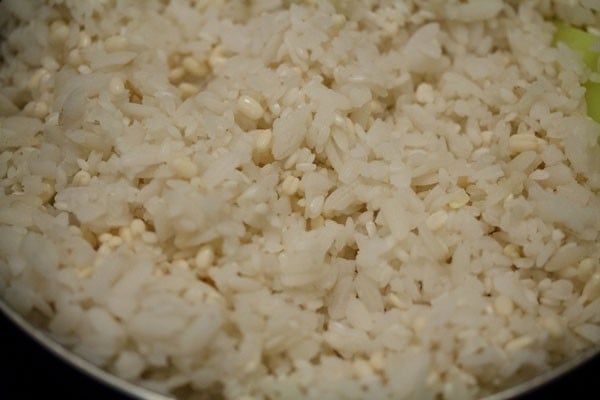
8. Now add half of the soaked ingredients in a wet grinder jar. Depending on the size of the jar, you can add half or full.
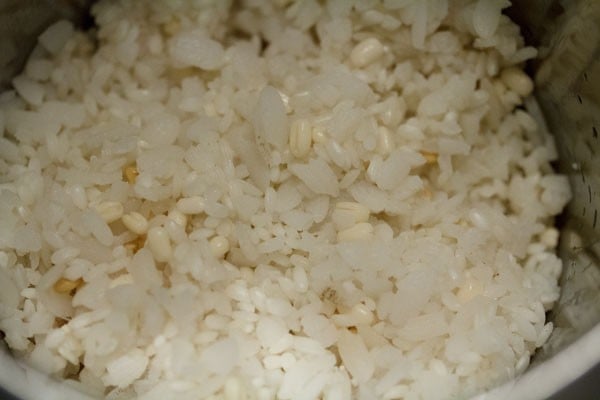
9. Add ½ cup water and grind very well. The rice grains can have a consistency of that like idli rawa.
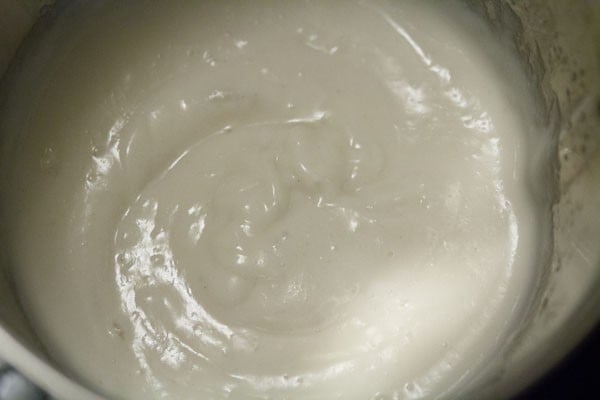
10. Now pour the batter in a large bowl.
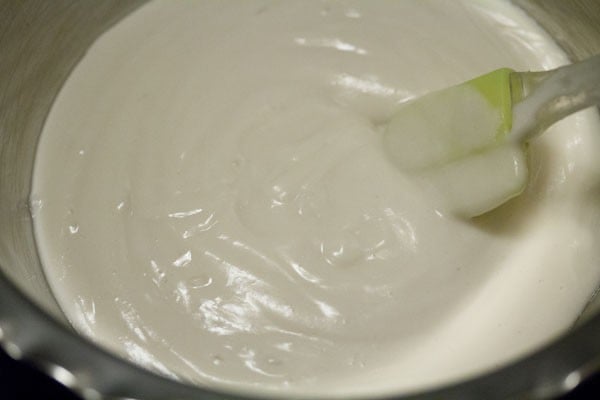
11. I ground the batter in two batches and overall used 1 cup water. If the grinder becomes hot, then wait for it to cool down and then continue with the grinding.
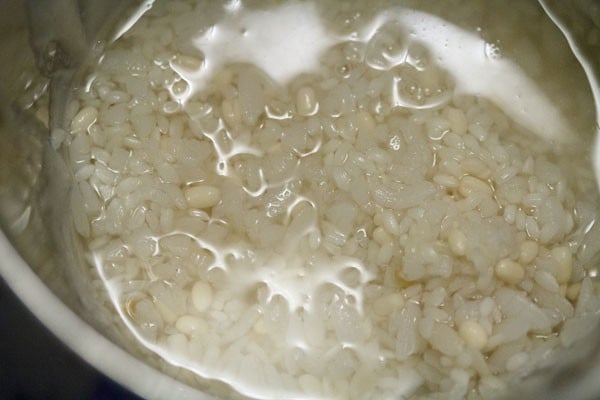
12. Add this ground batter to the bowl as well. Mix very well.
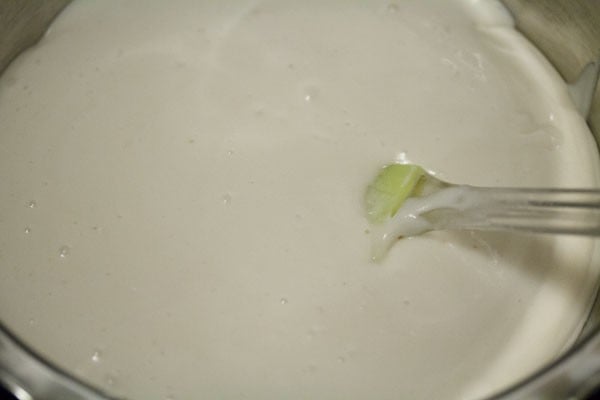
13. Then add ½ teaspoon rock salt and ½ teaspoon sugar. Don’t worry the taste of sugar is not felt in the idlis.
If you live in a hot or warm tropical climate, then no need to add sugar. Skip adding salt if the temperature is too cold in your city.
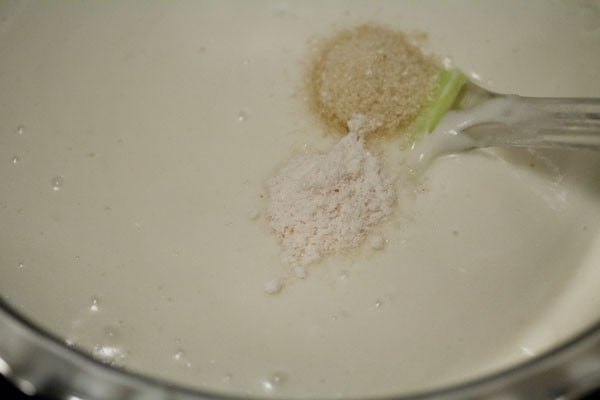
14. Mix very well.
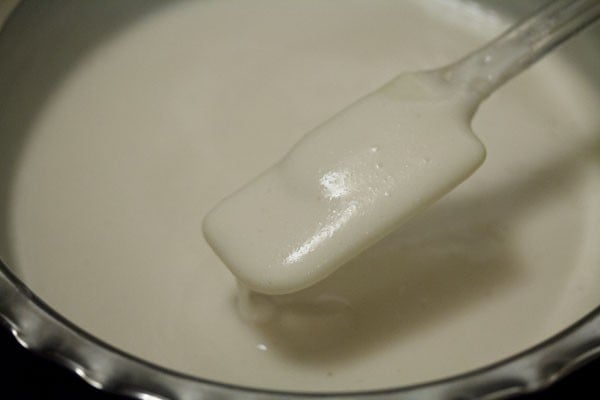
15. Cover the bowl with a lid and keep the bowl for 8 to 9 hours or more depending on the temperature conditions in your city.
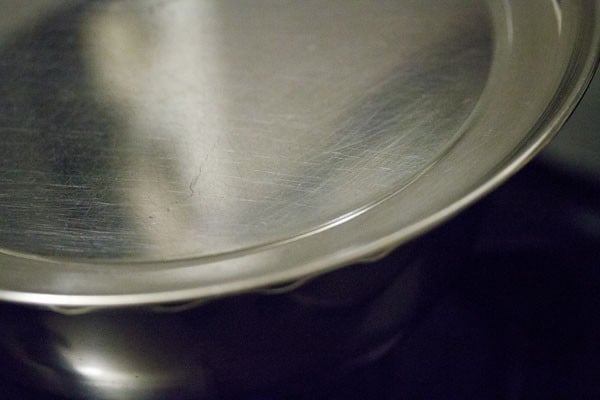
16. This is the batter, the next day.
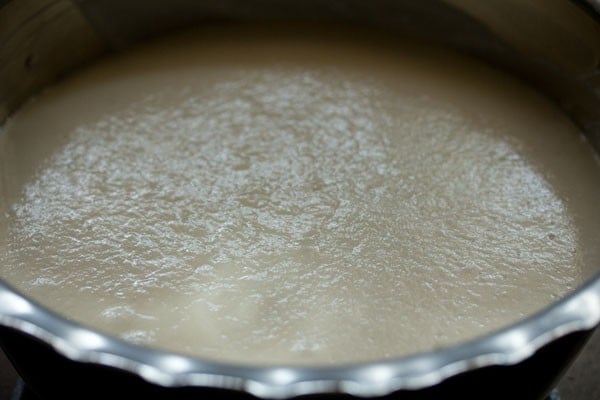
17. Add ⅛ to ¼ teaspoon baking soda. This is optional. You can add baking soda if you want more softer idlis or if the batter has not fermented well.
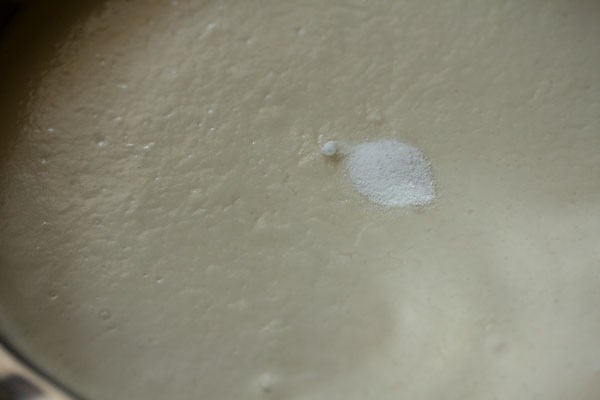
18. Mix the baking soda very well with the poha idli batter.
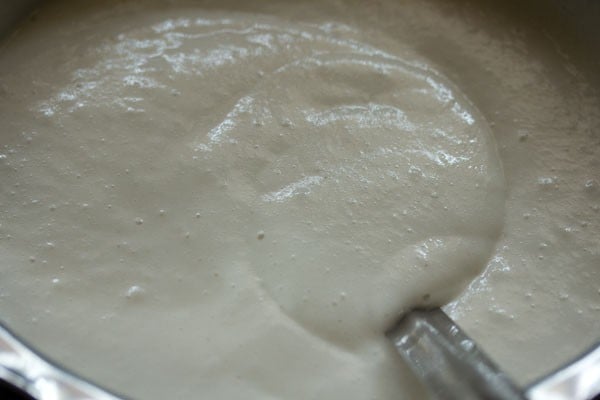
Steaming poha idli
19. Grease the idli moulds with oil. Pour the batter in the moulds.
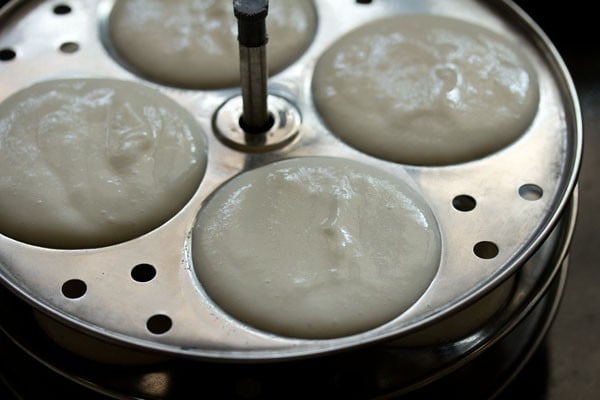
20. Before placing the idli stand, add 2 to 2.5 cups water in an electric cooker or steamer or pressure cooker. Bring this water to a boil. Then place the idli stand in the hot water.
For an electric cooker and steamer cover with its lid and steam. For pressure cooker, remove the vent weight/whistle from the cooker and secure the lid tightly on the cooker.
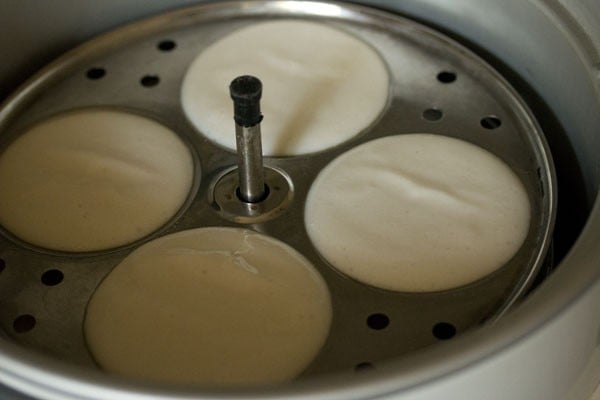
21. Steam aval idli for 12 to 15 minutes. Depending on the equipment you have used, it may take less or more time. A toothpick inserted in the center of the poha idli should come out clean and not be sticky.
Allow a standing time of 1 to 2 minutes. You can steam the idlis in batches. The leftover batter can be refrigerated and you can make paniyaram or sweet paniyaram from them. From this batter, dosa cannot be made.
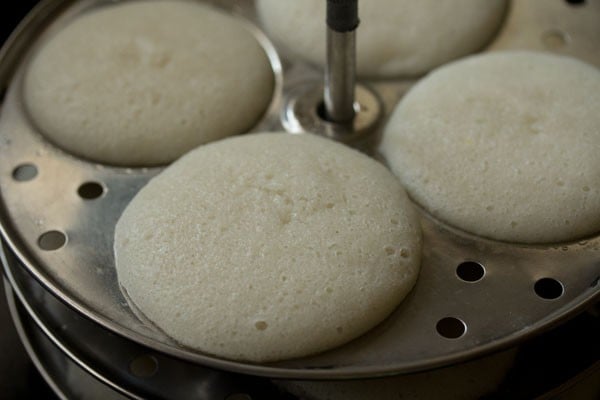
22. Dip a spoon or butter knife in water and slid them through the idlis. Remove and place the idlis in a warm container like a casserole.
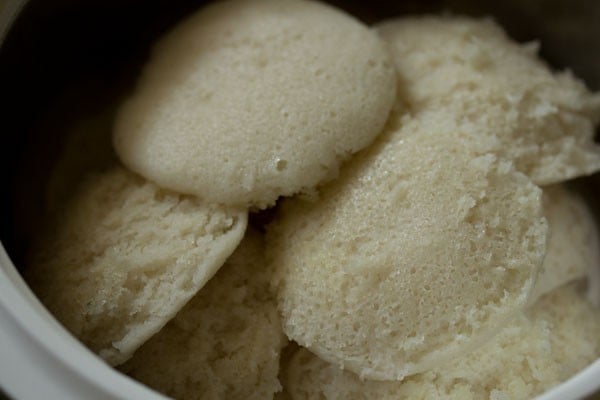
23. Serve poha idli hot with coconut chutney and idli sambar or with veg kurma.
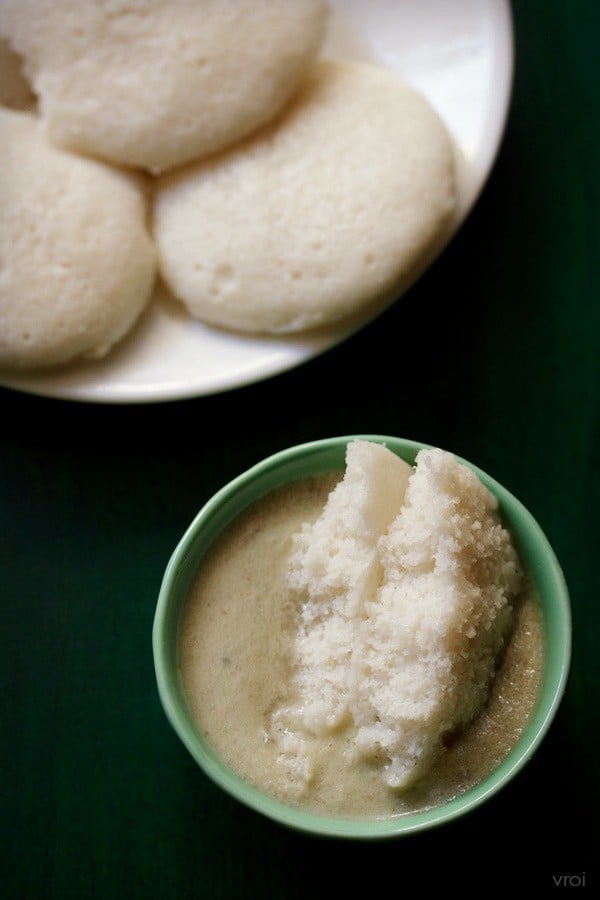
If you are looking for more Indian breakfast recipes then you may like:
Please be sure to rate the recipe in the recipe card or leave a comment below if you have made it. For more vegetarian inspirations, Sign Up for my emails or follow me on Instagram, Youtube, Facebook, Pinterest or Twitter.
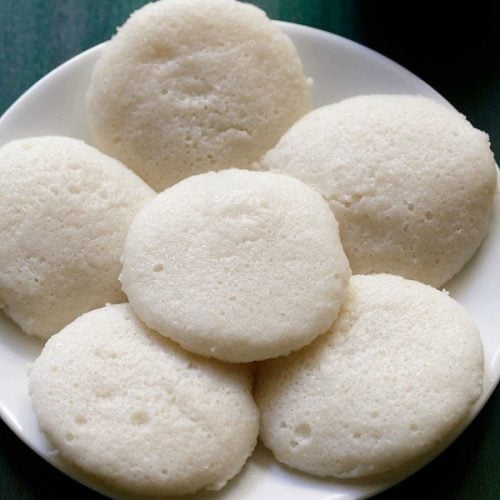
poha idli
Ingredients
- 1 cup idli dosa rice or parboiled rice or 200 grams idli dosa rice
- 1 cup thick poha or 80 grams thick poha (parched rice or aval)
- 3 tablespoon whole urad dal (husked whole black gram) or 40 grams whole urad dal (you can also use husked split urad dal),
- ¼ teaspoon methi seeds (fenugreek seeds)
- 2.5 cups water for soaking
- 1 cup water for grinding
- ½ teaspoon sugar (optional)
- ½ teaspoon rock salt (edible and food grade)
- 1/8 to ¼ teaspoon baking soda (optional)
- oil for greasing the idli moulds
Instructions
soaking
- In a bowl or pan, take the following ingredients – idli dosa rice or parboiled rice, whole urad dal, and 1/4 tsp fenugreek seeds.
- Rinse them for a couple of times and then soak in 2.5 cups water.
- In a separate bowl or pan, take the thick poha .
- Rinse the poha once or twice with water.
- Drain and add the poha to the bowl containing rice, urad dal, methi seeds and water.
- Mix well. Cover the pan and soak these four ingredients in water for 5 to 6 hours.
grinding poha idli batter
- Later strain and reserve the strained water.
- Now add half of the soaked ingredients in a wet grinder jar. Depending on the size of the jar, you can add half or full. I ground in two batches.
- Add 1/2 cup water and grind very well. The rice grains can have a consistency of that like idli rawa.
- Now pour the batter in a large bowl.
- I ground the batter in two batches and overall 1 cup water. If the grinder becomes hot, then wait for it to cool down and then continue with the grinder.
- Then add 1/2 tsp rock salt and 1/2 tsp sugar. Don’t worry the taste of sugar is not felt in the idlis.
- If you live in a hot or warm tropical climate, then no need to add sugar. Mix very well.
fermenting poha idli batter
- Cover the bowl with a lid and keep the bowl for 8 to 9 hours or more depending on the temperature conditions in your city.
- Add 1/8 tsp to 1/4 tsp baking soda and mix very well. This is optional. You can add baking soda if you want more softer idlis or if the batter has not fermented well.
making poha idli
- Grease the idli moulds with oil. Pour the batter in the moulds.
- Before placing the idli stand, add 2 to 2.5 cups water in an electric cooker or steamer or pressure cooker. Bring this water to a boil. Then place the idli stand in the hot water.
- For an electric cooker and steamer cover with its lid and steam. For pressure cooker, remove the vent weight/whistle from the cooker and secure the lid tightly on the cooker.
- Steam the idli for 12 to 15 minutes. Depending on the equipment you have used, it may takes less or more time.
- A tooth pick inserted in the center of the idlis should come out clean and not be sticky. Allow a standing time of 1 to 2 minutes.
- Dip a spoon or butter knife in water and slid them through the aval idlis. Remove and place the idli in a warm container like a casserole.
- Serve poha idli with coconut chutney and an onion sambar or mix veg sambar.
This Poha Idli post from the blog archives first published in December 2015 has been updated and republished on December 2022.








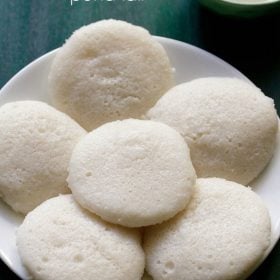
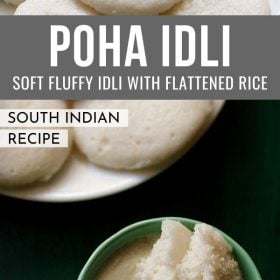
Hi Dassna,
I used your recipe recently but halved the amount of every ingredient. I live in a tropical country. The batter did not rise even after 12 hours. I did not add sugar, yeast or even baking soda as I am averse to all these ingredients. I kept the batter for another day. Still no luck. It was of liquid(watery) consistency. So decided to make dosa two days later. What could have gone wrong?
1. Is it necessary to soak all ingredients together or could I do it separately?
2. Your write up says 1:1( idli rice:poha) in cup version but in metric measurement it is 200g:80g. Care to elaborate the anomaly?
3. If I soak and grind them separately, which ingredient should be ground first? I am using a blender to grind by the way.
Thank you for your reply.
selvi, if the batter does not ferment well, most of the times it is due to a low room temperature. but since you mention you live in a tropical climate, the reasons for batter not fermenting would be the quality of water, batter not ground very well or less water in the batter.
1. you can soak the ingredients separately also.
2. 1:1 proportion is for cup measurement and not metric.
3. first grind the urad dal, methi seeds and poha. as the quantity of urad dal is less, so better to add poha and grind together. grind to a smooth batter. then remove in a bowl or pan. add rice and grind.
welcome and thanks.
Hi Dassna,
I tried my luck again yesterday. I soaked all the ingredients separately and ground them separately even before I saw your reply. Slight fermented smell but batter still did not rise like the normal idli rice recipe where the urad dal quantity is higher. The only reason why I fancy this poha idli recipe is because I need to cut down on legumes and lentils as my potassium level is borderline high. Therefore, this recipe is godsend but then again it is a high carbo recipe-rice flakes and idli rice-which hopefully does not spike up my sugar level. I love idlis- best for breakfast, lunch and dinner. I will try and try until I can get perfect this recipe and I get idlis like I see in your posted images. Thank you once again.
hi selvi, i am wondering what is going wrong with the fermentation. this poha idli batter ferments but there will be a slight rise. i forgot to mention this point in my last reply. the batter won’t double or triple like the regular idli batter. and this is the reason that baking soda is added to the batter.
an alternative for you is to add 1/4th teaspoon yeast (instant yeast). dissolve instant yeast in 2 to 3 tablespoons water and then add this solution to the idli batter after the batter is fermented. mix well. cover and keep it aside at room temperature for 30 to 45 minutes. the batter will get the tiny air pockets and become fluffy. then make idlis. the downside of this method is that you will need to use the entire batter in one go. even if you keep in the fridge, the batter will keep on leavening and get a yeasty aroma and taste. an option here is to freeze the batter and use it later.
with regards to your health considerations, you have a look at below two idli recipes made with foxtail millet and okra which i have already shared on the blog.
Hi dassana,
I ground this batter last night and kept it for fermentation till tonight. I also added sugar in the batter to help the process.
But due to cold weather+rains, it didn’t rise much. There were small bubbles and yeasty smell though. I added salt and made first batch.
But the idling came out a bit too dense. I have made triple amount batter.
Is there something I can do to improve the remaining batch?
Also should I keep the batter outside the fridge till it gets over?
ruchi, the batter has not fermented well due to the cold climate. keep the batter in a warm place or near a heater. you also keep in sunlight if you get some sun during the day. just keep for some hours, like 3 to 4 hours. or you can heat an oven at 80 to 90 degrees celsius for 15 minutes. then switch off oven and keep the idli batter in it for some hours. or if your oven has lights, then lit the oven and keep the batter in it. for a lit oven no need to preheat the oven.
Thank you for responding.
You were right, it hadn’t fermented well. I kept it for one more full night & it rose very well. The idlis came out perfect then.
But there was one thing.. the idlis had some orange streaks/spots. Do you have any idea what caused that? There was no issue in tast & texture.
Also, if I plan to ferment one more batch, can I pour the new batch of batter in the same container? I just finished making idlis with the last batter. There is residual batter sticking in the bowl. So I was thinking if pouring in the same bowl will speed up the next fermentation (like in curd)?
welcome ruchi. i guess the spots are due to bacterial fermentation. this happened with me while fermenting curd. if the taste and smell is not off or weird, then the batter should be fine to use.
of course, you can use the same container. it will speed up the process. even a spoon of leftover batter can be freezed or refrigerated and added to fresh batter. it helps in fermentation and speeds it up, especially in cold climates. since the bacteria culture is present in the leftover batter. this method can also be used while fermenting bread dough.
Dear DAssana
this is Arusha ….u have replied to my querry in khatta dhokla.
u have mentioned about cold temperature. I have question there but cant write on this open box. do u have email id? I can write there.
or WhatsApp?
arusha, i have received your email. i will reply you shortly.
Hi Dassana
Good morning !
I tried this one this time and had trouble making these too, i cant figure out what and where i have been wrong in the process..also the idli texture has come out very unexpected i have taken pictures, if you dont mind can i share them with you if you could provide me your email address or anywhere where i could share them. As i have prepared this batter in large quantity which i usually and dont want it to get wasted.
Thank you
Samrinder
samrinder, you can send me the images on my email id shared in the about page.
after seeing the pics, i can tell what must have gone wrong.
Hi dassana, I’v tried this recipe many times by now and idlis always turn out amazing. There’s just a little glitch that i face every time- that the idlis come out a little denser than the ones shown in your pic. I’m listing out some things that I do:
1. I use khichari rice since I don’t get idli rice here (i thought basmati rice would be a bit ‘hard’ for idli)
2. I uncover the lid of steamer immediately after 10-12 min of steaming to avoid water droplet formation over idlis.
3. i prepare triple amount of batter and refrigerate it after fermentation. i use it over period of 3-4 days. Idlis turn out more dense on later days i’ve noticed
Though the taste and aroma of idlis always turns out perfect, it is just the texture that i want to improve. Thanks
ruchi, everything is fine. just add some more water to the batter. if less water is added, then the idlis turn out dense. the water ratio is important.